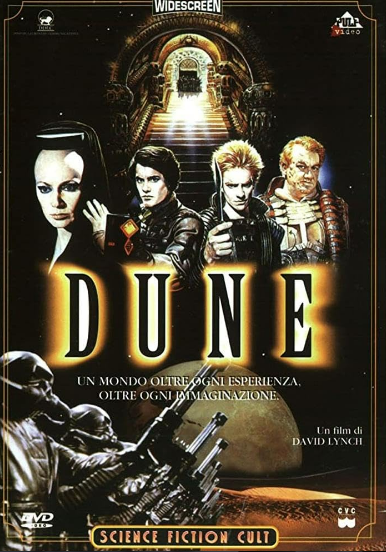
Dune is a 1984 science fiction film directed by David Lynch, based on the novel of the same name by Frank Herbert.
Before going ahead with this review I want to clarify that this review refers to the first Dune movie exactly 40 years ago.
In 2021 there was a review of it directed by Denis Villeneuve and written by Eric Roth, Jon Spaihts and the director himself.
It is an international co-production of the United States, United Kingdom, Canada and Hungary and is the first installment of two films based on a new revised version faithful to Frank Herbert's 1965 novel of the same name.
It is not to this film that I am referring but to its original, so to speak.

In the year 10191, humanity is spread out among the stars and the known universe is ruled by the Landsraad, a feudal system in which the great houses, owners of entire planets, are in constant struggle for power.
The plot initially involves four different planets.
Dune is David Lynch's first science fiction film.
Planet Caladan, home of House Atreides:
Young Paul has gone through hard training, as he is the only son and heir that Duke Leto Atreides, known as "The Just," had with his beloved concubine Lady Jessica. However, Jessica is part of a very secret genetic program of the Bene Gesserit Sisterhood. This millenary program aims to obtain, through a series of blood crosses between the houses, the Kwisatz Haderach, the supreme being who will rule the universe. The unexpected birth of Paul has upset the Bene Gesserit's plans.
Planet Giedi Prime, home of House Harkonnen:
The cruel Baron Vladimir Harkonnen, sworn enemy of the Atreides, has planned the complete extinction of his adversaries through a plot hatched with the secret complicity of Emperor Shaddam IV, who fears the growing popularity of Duke Leto within the Landsraad due to a weapon created by the Atreides.
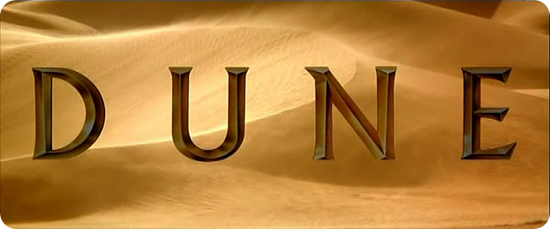
Planet Kaitain, home of the Imperial House Corrino:
The Emperor of the known universe, Padishah Shaddam IV, is under considerable pressure from the Space Guild. The Guild's monstrous Navigators are mutated with Spice gas to be able to cross space with their thoughts, to move the Guild's immense ships from one side of the cosmos to the other. The Navigators, partially endowed with precognition, perceive the danger that Paul Atreides represents and would like to eliminate him.
Planet Arrakis (Dunes) - the only place of spice extraction:
The Harkonnen have abandoned the planet, which they had ruthlessly exploited to extract the precious spice, replaced by the Atreides, their adversaries, by imperial order. The trap is set and the massacre will be inevitable. Arrakis, a desert and inhospitable planet, is populated by a mysterious people, the Fremen, capable of riding on gigantic sand worms. The Fremen, who call their planet Dune, have long awaited the arrival of a Messiah, the Mahdi, who will lead them, after centuries of persecution, in a bloody jihad to conquer the planet. He who controls La Spezia, controls the universe.

The first popular chapter of the Dune series written by Frank Herbert had often been listed among the books "impossible" to translate to the big screen, not only because of the large amount of special effects required (which in 1984 did not yet exploit digital techniques and were very expensive), but above all for the remarkable complexity of the plot and for the particular narrative style used by Herbert in his novel, based largely on interior monologues, deep and endowed with different levels of reading, with a plot involving a large number of different characters.
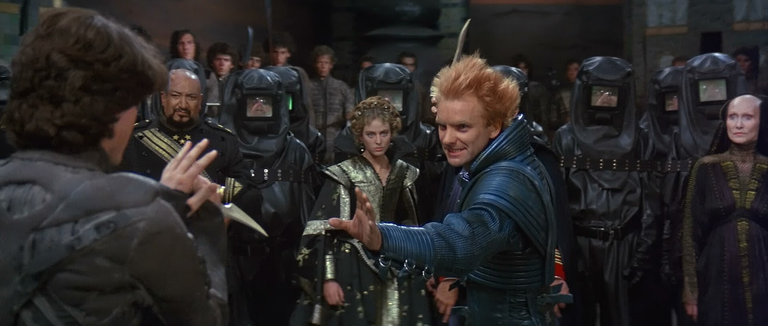
David Lynch's , on the other hand, was not the first attempt to bring Dune to the big screen: in the twenty years since the book's publication there had been several regularly failed projects, among which the most advanced was due to Alejandro Jodorowsky, who had involved several artists who later became famous, from Chris Foss to Moebius and HR Giger, even proposing Salvador Dalí for the role of the Emperor.
It was the producer Dino De Laurentiis who entrusted the direction to the young David Lynch, who also wanted to take charge of the script, collaborating with Frank Herbert himself. With a cost of 40 million dollars in 1984 (45 according to other estimates), Dune was considered one of the most spectacular and expensive science fiction productions in the history of cinema.
Until then, David Lynch, who had made a name for himself a few years earlier with The Elephant Man , had never made science fiction films. In fact, he had refused to direct Return of the Jedi, the third episode of the Star Wars saga, believing that the work was already too well defined by producer George Lucas.
Lynch had therefore never been faced with a production of such pharaonic dimensions as this one: three years to study the look together with set designer Anthony Masters (2001: A Space Odyssey); a year of work in Mexico City studios with four different teams on 75 sets with more than 600 people; 6 months of shooting with the actors and 6 months of post-production for the special effects.
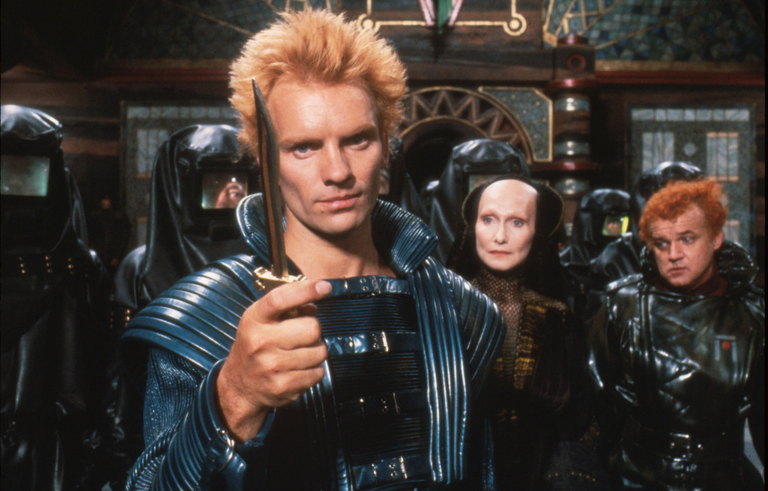
The costumes and sets for Dune were meticulously designed as Lynch conceived the scenes as living paintings: each planet and house were carefully studied and rendered with different sets, costumes, lights and photographs. At that time (1984) most sets in a science fiction film, from spaceships to grandiose buildings, had to be physically constructed, usually using small-scale models and ultimately taking advantage of editing to hide mistakes and imperfections. Lynch demanded the construction of huge, often full-scale sets (for this, the expertise of model maker Kit West, spaceship builder of the Star Wars saga, came in handy. Despite the efforts, today special effects suffer the consequences). technical limits of the time (since the 1990s, thanks to computer graphics, the use of special effects in the post-production phase has made it possible to reduce time and costs). Carlo Rambaldi was called to give life to the titanic arena). worms and the disturbing Navigators of the Space Guild, the greatest expert in mechanical creatures and "father" of ET the Extra-Terrestrial.
The set design and costumes are deliberately characterized by a nineteenth-century eclecticism, seemingly at odds with the late futuristic setting. As its readers know, conservative, feudal and anti-scientific behavior reigns in the Dune universe, resulting in deliberately backward technology. In apparent contrast to the fantasy filmography of the 1980s, with lights and pyrotechnic effects, there remain memories of the setting of the tales of Jules Verne, the mythological historical filmography of the 1960s and the science fiction of the 1950s.
The image of the House of Atreides, a lineage of ancient and honored military tradition[4], with its water planet Caladan, is characterized by a singular post-Baroque style, between Ludwig of Bavaria and modernism. The world of the Harkonnen, cruel and terrible, is characterized by the cold atmospheres and dark settings of their dark and polluted planet, Giedi Primo.

The initial choice of the main cast was made by Dino De Laurentiis himself with his daughter Raffaella, the film's producer, and included Freddie Jones (The Elephant Man) as the mentat Thufir Hawat, José Ferrer (Cyrano de Bergerac) as Emperor Padishah and Max Von Sydow (The Exorcist) as Dr. Liet-Kynes, the imperial planetary scientist. The female role of Chani is played by Sean Young, already famous for Blade Runner.
The other roles were played with more difficulty: Brad Dourif, after some reluctance, was convinced to play Piter DeVries, the evil mentat; German Jürgen Prochnow, who distinguished himself with the wartime submarine 96, was cast as Duke Leto the Just; the complex role of Lady Jessica, after several changes, went to Francesca Annis, who had already played Lady MacBeth in Roman Polanski's adaptation. Feyd-Rautha, the ambiguous and ruthless protégé of Baron Vladimir Harkonnen (Kenneth McMillan), was played by rock star Sting (the frontman of the band The Police at the time). Sting was initially one of the candidates for the lead role, that of Paul Atreides/Muad'dib.
For the role of the lead, over a hundred tapes of actors, known and unknown, were viewed before Kyle MacLachlan was chosen. The then unknown MacLachlan, who became Lynch's fetish actor in his later films, was a true enthusiast of Herbert's book and was perfect in the complex role of Paul, a young scion tormented by mystical dreams and visions, who matures and becomes leader and messiah. of the Fremen.
Among the many characters involved in the story are Gurney Halleck, Paul's master-at-arms, played by Shakespearean actor Patrick Stewart (later famous for another sci-fi role, that of Captain Jean Luc Picard in the TV series Star Trek: The Next Generation) and Shadout Mapes (Linda Hunt). Italian actress Silvana Mangano, wife of De Laurentiis, playing Reverend Mother Ramallo de la Bene Gesserit, gives her penultimate performance in this film.
It should be emphasized that the intimate thoughts of the characters are expressed through a voice-over, a much discussed choice, since many "purists" among critics and filmmakers believe that this function should be performed through dialogues.
Songs by Beethoven, Mahler, Shostakovich and Cherubini were used for the soundtrack, performed by the Vienna Philharmonic Orchestra and the rock band Toto. Symphonic and rock music, traditional instruments and synthesizers blend into a harmonious whole between old and new.
The film, which had aroused great expectation due to the notoriety of Herbert's books, was widely criticized on its release and was less successful commercially than expected: it cost between 40[2] and 45[3] million dollars. In Europe, the film spent several weeks at the top of the box office for several weeks. Despite the criticism, the film is now considered one of the cult films of science fiction cinema and has made handsome profits in the home video market.
The plot is really complex and sometimes obscure (especially for those who have not read the novel), and this despite the efforts of the director, who wrote six different drafts before the final script. The difficulty of comprehension derives in part from the inherent complexity of the original novel, but also from the heavy cuts the production made in the final version of the film to reduce its length.
Various rumors and legends have been spread about the true length of the film[6] and its hypothetical "lost" versions, including that of a mysterious 5 or 6 hour "full version" that no one has ever seen. This rumor may have been fueled by statements made by Herbert himself, who in the introduction to the book The Road to Dune, following the film, wrote: "I had the opportunity to influence some decisions regarding the film, even if I could not impose my idea on either the ending or the edits of the version that would be shown in the theater. Of the original five hours of the film, only two-fifths of it made it out of the editing room. What was cut?" Actually, it is quite normal for a film to arrive at the editing stage with several hours of footage, which is selected precisely at that stage.
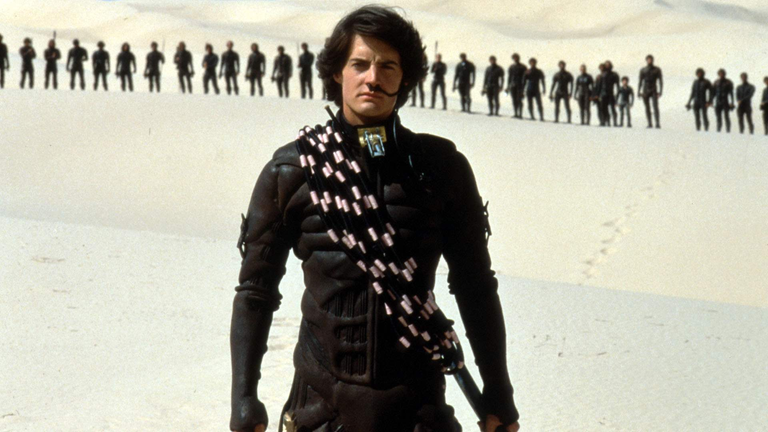
To shorten its length, many scenes were removed from the film and at least one secondary character was eliminated entirely (the wife Paul "inherits" from a Fremen killed in a duel).
However, it is false that the version of Dune distributed in theaters would derive from the "cannibalization" of two different films (Dune and its sequel).
Years later, reediting some scenes, an extended version of the film was edited for television, the so-called Allen Smithee version, which lasted 190 minutes, but which was far from being excellent in the editing, to the point that it was repudiated by the director himself (whose name was replaced by Allen Smithee, a pseudonym used by several directors).
After almost 20 years since the film's release, in 2000 a television miniseries entitled Dune, the Fate of the Universe (Frank Herbert's Dune) was based on Herbert's book, which aimed for a greater adherence to the original novel (thanks also to a total of 273 minutes). Although with a much smaller budget, this miniseries at times resembles a remake of Lynch's film, due to the similarity of numerous scenes and dialogues. This miniseries had a sequel in 2003 with Children of Dune.

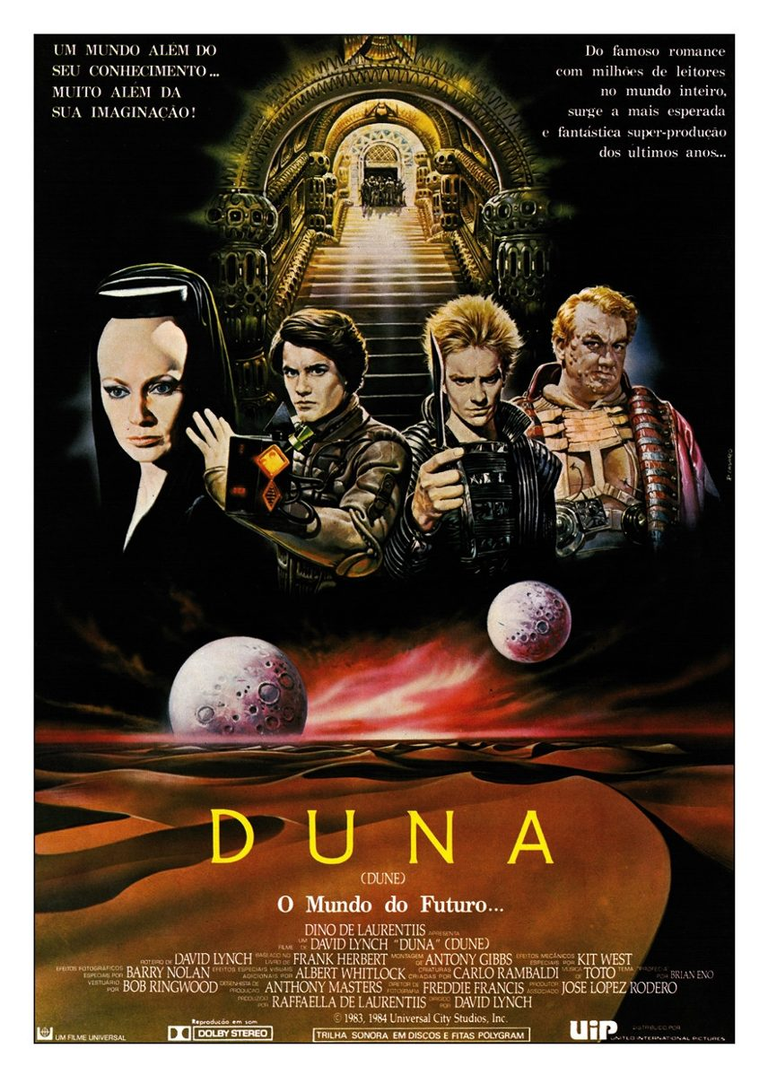
Dune es una película de ciencia ficción de 1984 dirigida por David Lynch, basada en la novela homónima de Frank Herbert.
Antes de seguir adelante con esta reseña quiero aclarar que la misma se refiere a la primera película de Dune hace exactamente 40 años atrás-
En el 2021 se hizo una review de la misma dirigida por Denis Villeneuve y escrita por Eric Roth, Jon Spaihts y el propio director.
Es una coproducción internacional de Estados Unidos, Reino Unido, Canadá y Hungría y constituye la primera entrega de dos películas basada en una nueva versión revisada fiel a la novela homónima de 1965 de Frank Herbert.
No es a esta película a la que me refiere sino a su original, por así llamarlo.

En el año 10191, la humanidad se extiende entre las estrellas y el universo conocido está gobernado por el Landsraad, un sistema feudal en el que las grandes casas, dueñas de planetas enteros, están en constante lucha por el poder.
La trama inicialmente involucra cuatro planetas diferentes.
Dune es la primera película de ciencia ficción de David Lynch.
Planeta Caladan, hogar de la Casa Atreides:
El joven Paul ha pasado por un duro entrenamiento, ya que es el único hijo y heredero que el duque Leto Atreides, conocido como "El Justo", tuvo con su amada concubina Lady Jessica. Sin embargo, Jessica es parte de un programa genético muy secreto de la Hermandad Bene Gesserit. Este programa milenario pretende obtener, a través de una serie de cruces de sangre entre las casas, el Kwisatz Haderach, el ser supremo que gobernará el universo. El inesperado nacimiento de Paul ha trastocado los planes de la Bene Gesserit.
** Planeta Giedi Prime, hogar de la Casa Harkonnen:**
El cruel barón Vladimir Harkonnen, enemigo jurado de los Atreides, ha planeado la completa extinción de sus adversarios mediante un complot urdido con la complicidad secreta del emperador Shaddam IV, quien teme la creciente popularidad del duque Leto dentro del Landsraad debido a un arma creada por los Atreides.
Planeta Kaitain, hogar de la Casa imperial Corrino:
El emperador del universo conocido, Padishah Shaddam IV, está bajo una presión considerable por parte del Space Guild. Los monstruosos Navegantes del Gremio son mutados con gas Especia para poder cruzar el espacio con sus pensamientos, para trasladar las inmensas naves del Gremio de un lado al otro del cosmos. Los Navegantes, parcialmente dotados de precognición, perciben el peligro que representa Paul Atreides y quisieran eliminarlo.
Planeta Arrakis (Dunas) - el único lugar de extracción de especias:
Los Harkonnen han abandonado el planeta, que habían explotado sin piedad para extraer la preciada especia, sustituidos por los Atreides, sus adversarios, por orden imperial. La trampa está tendida y la masacre será inevitable. Arrakis, un planeta desértico e inhóspito, está poblado por un misterioso pueblo, los Fremen, capaces de montar sobre gigantescos gusanos de arena. Los Fremen, que llaman a su planeta Dune, llevan mucho tiempo esperando la llegada de un Mesías, el Mahdi, que les conducirá, tras siglos de persecución, en una sangrienta yihad para conquistar el planeta. Quien controla La Spezia, controla el universo.
El primer capítulo popular de la serie Dune escrito por Frank Herbert había sido catalogado a menudo entre los libros "imposibles" de traducir a la gran pantalla, no sólo por la gran cantidad de efectos especiales necesarios (que en 1984 aún no explotaban las técnicas digitales y eran muy caras), pero sobre todo por la notable complejidad de la trama y por el particular estilo narrativo utilizado por Herbert en su novela, basada en gran medida en monólogos interiores, profundos y dotados de diferentes niveles de lectura, con una trama que implica una gran cantidad de personajes diferentes.

El de David Lynch , por el contrario, no fue el primer intento de llevar Dune a la gran pantalla: en los veinte años transcurridos desde la publicación del libro se habían producido varios proyectos regularmente fracasados, entre los que el más avanzado se debía a Alejandro Jodorowsky, que había involucrado a varios artistas que luego se hicieron famosos, desde Chris Foss hasta Moebius y HR Giger, proponiendo incluso a Salvador Dalí para el papel del Emperador.
Fue el productor Dino De Laurentiis quien confió la dirección al joven David Lynch, quien también quiso encargarse del guión, colaborando con el propio Frank Herbert. Con un coste de 40 millones de dólares en 1984 (45 según otras estimaciones), Dune fue considerada una de las producciones de ciencia ficción más espectaculares y caras de la historia del cine.
Hasta entonces, David Lynch, que se había hecho famoso unos años antes con El hombre elefante , nunca había hecho películas de ciencia ficción. De hecho, se había negado a dirigir El retorno del Jedi, el tercer episodio de la saga Star Wars, creyendo que la obra ya estaba demasiado definida por el productor George Lucas.
Por lo tanto, Lynch nunca se había enfrentado a una producción de dimensiones faraónicas como ésta: tres años para estudiar el aspecto junto con el escenógrafo Anthony Masters (2001: Odisea en el espacio); un año de trabajo en los estudios de la Ciudad de México con cuatro equipos diferentes en 75 sets con más de 600 personas; 6 meses de rodaje con los actores y 6 meses de postproducción para los efectos especiales.
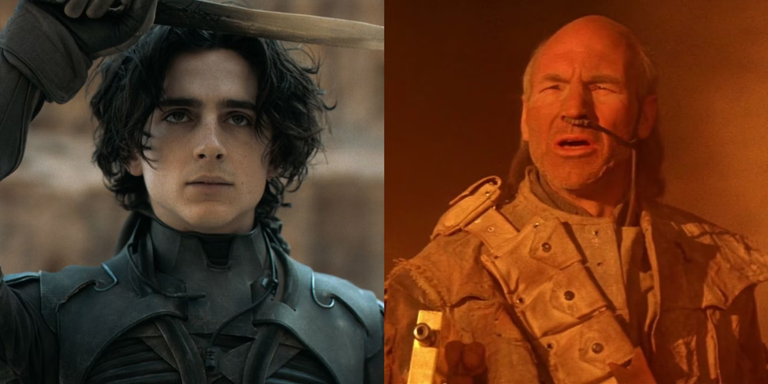
El vestuario y los decorados de Dune fueron diseñados meticulosamente mientras Lynch concebía las escenas como pinturas vivas: cada planeta y cada casa fueron cuidadosamente estudiados y renderizados con diferentes decorados, vestuario, luces y fotografías. En aquella época (1984) la mayoría de los decorados de una película de ciencia ficción, desde naves espaciales hasta edificios grandiosos, debían construirse físicamente, generalmente utilizando modelos a pequeña escala y, en última instancia, aprovechando el montaje para ocultar errores e imperfecciones. Lynch exigió la construcción de decorados enormes, a menudo a escala natural (para ello, la experiencia del modelista Kit West, constructor de naves espaciales de la saga Star Wars, fue útil. A pesar de los esfuerzos, hoy en día los efectos especiales sufren las consecuencias). límites técnicos de la época (a partir de los años noventa, gracias a la infografía, el uso de efectos especiales en la fase de postproducción permite reducir tiempos y costes). Carlo Rambaldi fue llamado para dar vida a la arena titánica). gusanos y los inquietantes Navegantes del Gremio Espacial, el mayor experto en criaturas mecánicas y "padre" de ET el Extraterrestre.
La escenografía y el vestuario se caracterizan deliberadamente por un eclecticismo decimonónico, aparentemente en conflicto con la ambientación futurista tardía. Como saben sus lectores, en el universo de Dune reina un comportamiento conservador y feudal y anticientífico que da como resultado una tecnología deliberadamente atrasada. En aparente contraste con la filmografía fantástica de los años ochenta, con luces y efectos pirotécnicos, quedan recuerdos de la ambientación de los cuentos de Julio Verne, de la filmografía histórica mitológica de los años sesenta y de la ciencia ficción de los cincuenta.
La imagen de la Casa Atreides, un linaje de antigua y honrada tradición milita, con su planeta acuático Caladan, se caracteriza por un singular estilo posbarroco, entre Luis de Baviera y el modernismo. El mundo de los Harkonnen, cruel y terrible, se caracteriza por las atmósferas frías y los escenarios oscuros de su oscuro y contaminado planeta, Giedi Primo.
La elección inicial del reparto principal corrió a cargo del propio Dino De Laurentiis junto a su hija Raffaella, productora de la película, e incluía a Freddie Jones (El hombre elefante) como el mentat Thufir Hawat, José Ferrer (Cyrano de Bergerac) como el emperador Padishah y Max Von Sydow (El exorcista) como el Dr. Liet-Kynes, el científico planetario imperial. El papel femenino de Chani lo interpreta Sean Young, ya famoso por Blade Runner.
Los demás papeles fueron desempeñados con mayor dificultad: Brad Dourif, después de algunas desganas, fue convencido para interpretar a Piter DeVries, el malvado mentat; al alemán Jürgen Prochnow, que se distinguió con el submarino 96 en tiempos de guerra, se le asignó el papel del duque Leto el Justo; el complejo papel de Lady Jessica, tras varios cambios, recayó en Francesca Annis, que ya había interpretado a Lady MacBeth en la adaptación de Roman Polanski. Feyd-Rautha, el ambiguo y despiadado protegido del barón Vladimir Harkonnen (Kenneth McMillan), fue interpretado por la estrella de rock Sting (el líder de la banda The Police en ese momento). Sting fue inicialmente uno de los candidatos para el papel principal, el de Paul Atreides/Muad'dib.
Para el papel del protagonista, se vieron más de cien cintas de actores, conocidos y desconocidos, antes de elegir a Kyle MacLachlan. El entonces desconocido MacLachlan, que se convirtió en el actor fetiche de Lynch en sus películas posteriores, fue un auténtico entusiasta del libro de Herbert y se mostró perfecto en el complejo papel de Paul, un joven vástago atormentado por sueños y visiones místicas, que madura y se convierte en líder y mesías. de los Fremen.
Entre los numerosos personajes que intervienen en la historia, cabe mencionar a Gurney Halleck, el maestro de armas de Paul, interpretado por el actor shakesperiano Patrick Stewart (más tarde famoso por otro papel de ciencia ficción, el del capitán Jean Luc Picard en la serie televisiva serie Star Trek: La próxima generación) y Shadout Mapes (Linda Hunt). La actriz italiana Silvana Mangano, esposa de De Laurentiis, encarnando a la Reverenda Madre Ramallo de la Bene Gesserit, ofrece su penúltima actuación en esta película.
Hay que subrayar que los pensamientos íntimos de los personajes se expresan a través de una voz en off, una elección muy discutida, dado que muchos "puristas" entre críticos y cineastas creen que esta función debería realizarse mediante diálogos.
dunas4
Para la banda sonora se utilizaron canciones de Beethoven, Mahler, Shostakovich y Cherubini, interpretadas por la Orquesta Filarmónica de Viena y la banda de rock Toto. La música sinfónica y el rock, los instrumentos tradicionales y los sintetizadores se mezclan en un todo armonioso entre lo antiguo y lo nuevo.
La película, que había despertado una gran expectación debido a la notoriedad de los libros de Herbert, fue objeto de numerosas críticas en su estreno y obtuvo un éxito comercial menor de lo esperado: costó entre 40[2] y 45[3] millones de dólares. , sólo recuperó 31 en EE.UU.[2][5] En Europa, la película estuvo durante varias semanas en lo más alto de la taquilla. A pesar de las críticas, la película se considera hoy una de las películas de culto del cine de ciencia ficción y ha obtenido abundantes beneficios en el mercado del vídeo doméstico.
La trama es realmente compleja y a veces oscura (especialmente para aquellos que no han leído la novela), y esto a pesar de los esfuerzos del director, que escribió seis borradores diferentes antes del guión final. La dificultad de comprensión deriva en parte de la complejidad inherente a la novela original, pero también de los fuertes recortes que realizó la producción en la versión final de la película para reducir su duración.
Se han difundido diversos rumores y leyendas sobre la verdadera duración de la película[6] y sus hipotéticas versiones "perdidas", incluida la de una misteriosa "versión completa" de 5 o 6 horas que nadie ha visto nunca. Es posible que este rumor se haya visto alimentado por unas declaraciones del propio Herbert, quien en la introducción del libro The Road to Dune, a continuación de la película, escribió: «Tuve la oportunidad de influir en algunas decisiones relativas a la película, incluso si no No pude imponer mi idea ni en el final ni en los montajes de la versión que se proyectaría en el cine. De las cinco horas originales de la película, sólo dos quintas partes salieron de la sala de edición. ¿Qué se cortó?”. En realidad, es bastante normal que una película llegue a la fase de montaje con varias horas de metraje, que se selecciona precisamente en esa fase.
Para acortar su duración, muchas escenas fueron eliminadas de la película y al menos un personaje secundario fue eliminado por completo (la esposa Paul "hereda" de un Fremen asesinado en un duelo).
Sin embargo, es falso que la versión de Dune distribuida en cines derivaría de la "canibalización" de dos películas diferentes (Dune y su secuela).
Años más tarde, reeditando algunas escenas, se montó una versión ampliada de la película para televisión, la llamada versión de Allen Smithee, que duró 190 minutos, pero que dista mucho de ser excelente en el montaje, hasta el punto de que fue repudiado por el propio director (cuyo nombre fue sustituido por Allen Smithee, seudónimo utilizado por varios directores).
Después de casi 20 años desde el estreno de la película, en 2000 se basó en el libro de Herbert una miniserie de televisión titulada Dune, el destino del universo (Dune de Frank Herbert), que pretendía una mayor adherencia a la novela original (gracias también a una total de 273 minutos). Aunque con un presupuesto mucho menor, esta miniserie por momentos parece un remake de la película de Lynch, por la similitud de numerosas escenas y diálogos. Esta miniserie tuvo una secuela en 2003 con Children of Dune.
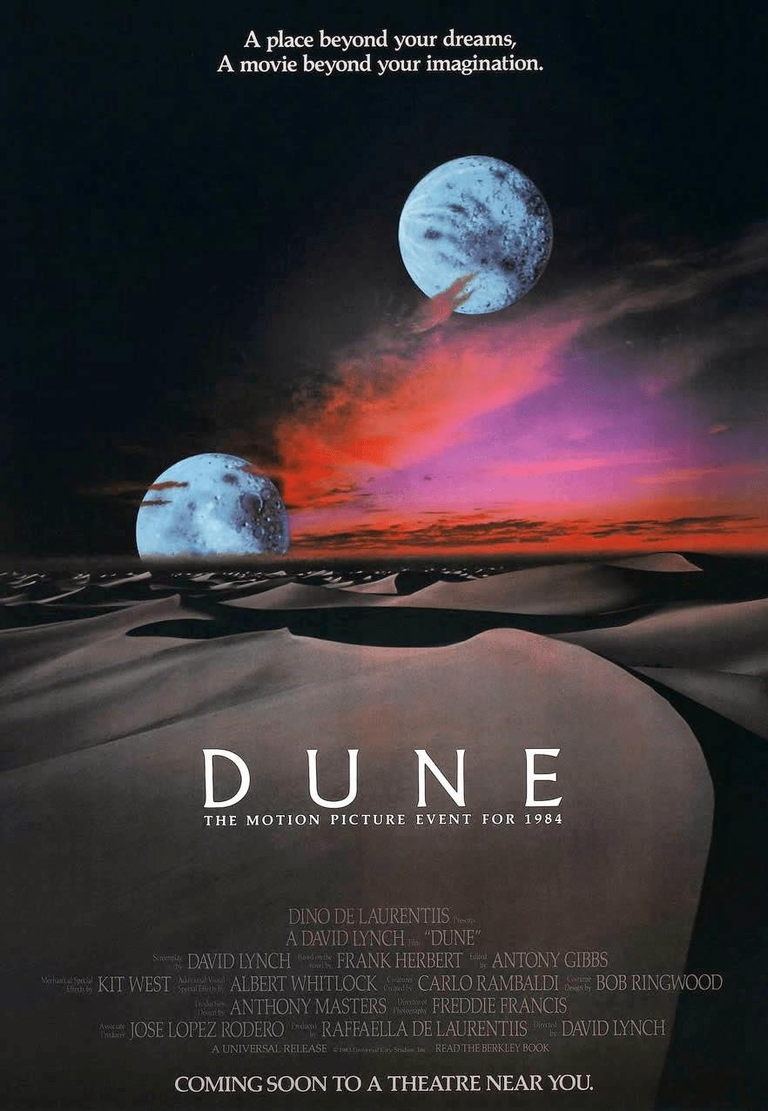
Source images / Fuente imágenes: IMDB.


Sources consulted (my property) for the preparation of this article. Some paragraphs may be reproduced textually.
Fuentes consultadas (de mi propiedad) para la elaboración del presente artículo. Algunos párrafos pueden estar reproducidos textualmente.
| Argentina Discovery. |  |
|---|---|
| Galería Fotográfica de Argentina. |  |
| Viaggio in Argentina. |  |
| Patagonia Express. |  |

Upvoted. Thank You for sending some of your rewards to @null. Get more BLURT:
@ mariuszkarowski/how-to-get-automatic-upvote-from-my-accounts@ blurtbooster/blurt-booster-introduction-rules-and-guidelines-1699999662965@ nalexadre/blurt-nexus-creating-an-affiliate-account-1700008765859@ kryptodenno - win BLURT POWER delegationNote: This bot will not vote on AI-generated content
Thanks @ctime!!!